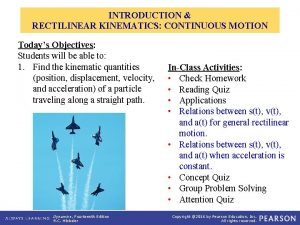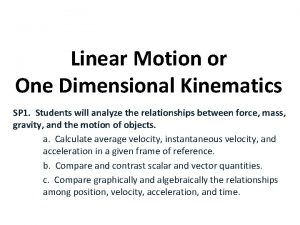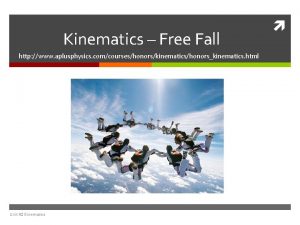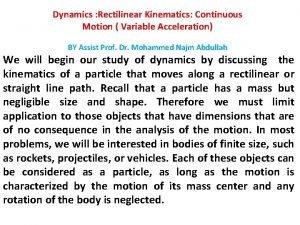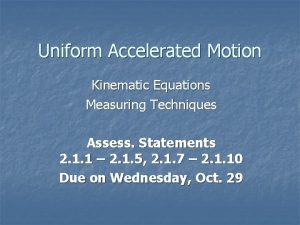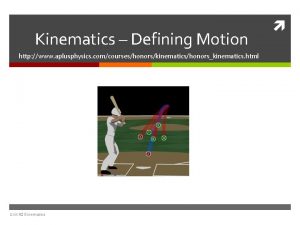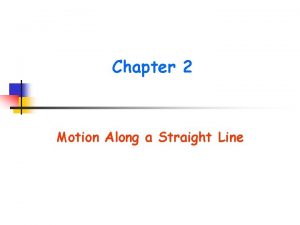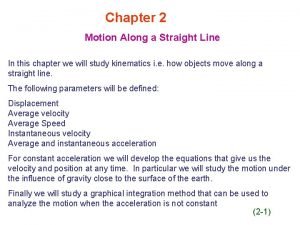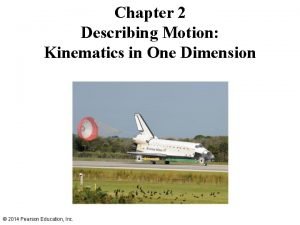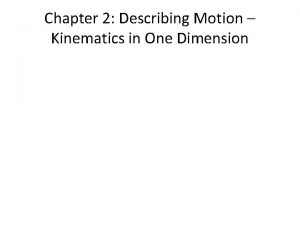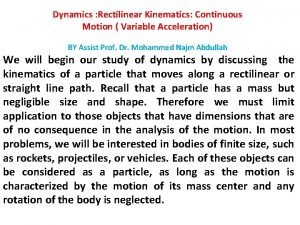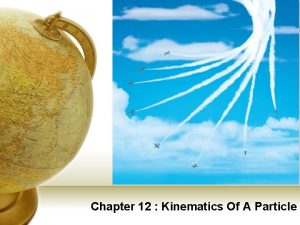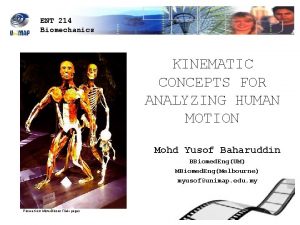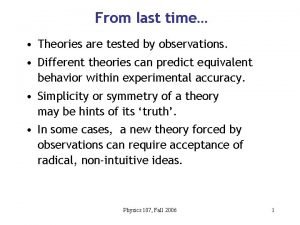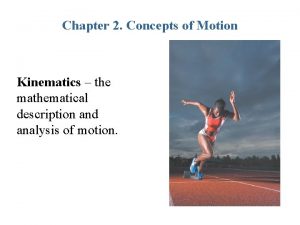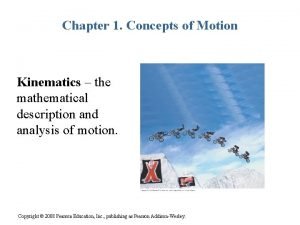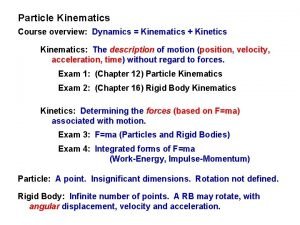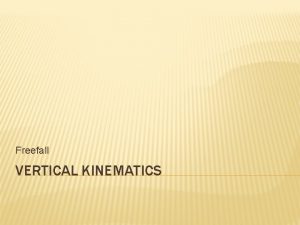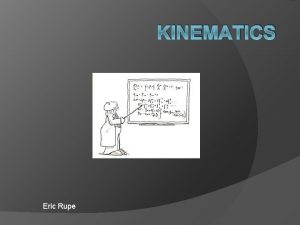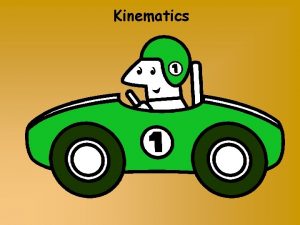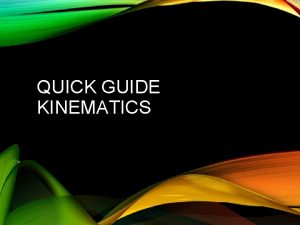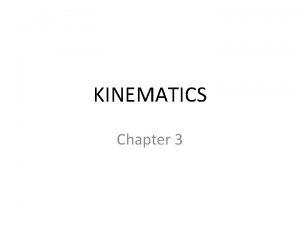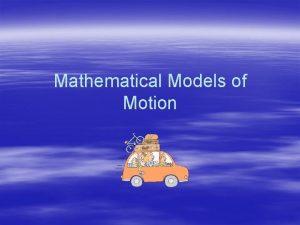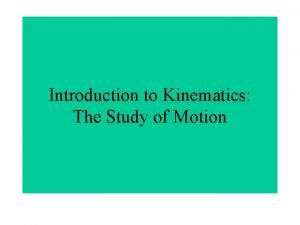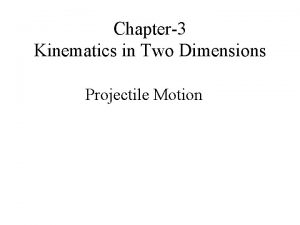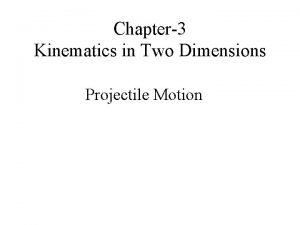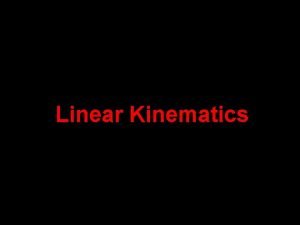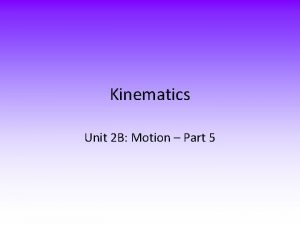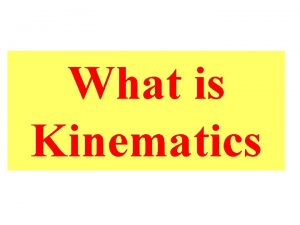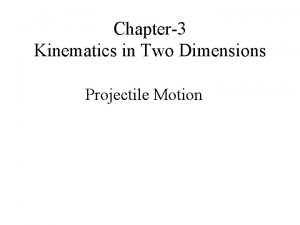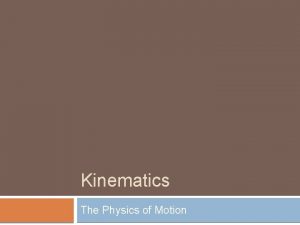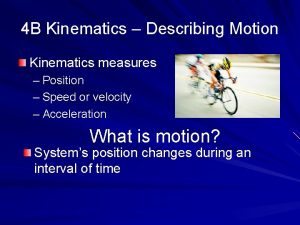Chapter 1 Concepts of Motion Kinematics the mathematical










































- Slides: 42

Chapter 1. Concepts of Motion Kinematics – the mathematical description and analysis of motion. Copyright © 2008 Pearson Education, Inc. , publishing as Pearson Addison-Wesley.

Chapter 1 Student Learning Objectives • • To analyze the motion of an object by using motion diagrams as a tool. To understand use the basic ideas of the particle model. To differentiate between concepts of position, velocity, and acceleration. To recognize the relationship between and when an object is speeding up, slowing down, curving, or at a turning point. To gain initial experience with graphical addition and subtraction of vectors. To begin the process of learning to analyze problem statements and to translate the information into other representations. To make and interpret graphs of motion. Copyright © 2008 Pearson Education, Inc. , publishing as Pearson Addison-Wesley.

Motion Diagrams – a movie without the camera • A non-moving movie camera takes photographs at a fixed rate, e. g. 30 photographs (or frames) every second. • Each is separated by the same time interval (here ∆t = 0. 033 s). • frames are all lined up one after the other in a filmstrip. • The moving car is in a somewhat different position in each frame. Copyright © 2008 Pearson Education, Inc. , publishing as Pearson Addison-Wesley.

Making a Motion Diagram • Cut frames apart, stack them on top of each other. • Project the entire stack at once onto a screen for viewing. • This composite photo, showing an object’s position at several equally spaced instants of time, is a motion diagram. Copyright © 2008 Pearson Education, Inc. , publishing as Pearson Addison-Wesley.

Which car is going faster, A or B? Assume there are equal intervals of time between the frames of both movies. Copyright © 2008 Pearson Education, Inc. , publishing as Pearson Addison-Wesley.

Examples of Motion Diagrams • Images equally spaced indicate constant speed • Increasing distance between images mean object is speeding up Copyright © 2008 Pearson Education, Inc. , publishing as Pearson Addison-Wesley.

Examples of Motion Diagrams • A decreasing distance between images shows the object is slowing down. • More complex motion shows both slowing down and speeding up. Copyright © 2008 Pearson Education, Inc. , publishing as Pearson Addison-Wesley.

The Particle Model – A simplifying assumption Consider the moving object as if all its mass were concentrated into a single point, without size or shape. An object that can be represented as a mass at a single point in space is called a particle. Copyright © 2008 Pearson Education, Inc. , publishing as Pearson Addison-Wesley.

Three motion diagrams are shown. Which is a dust particle settling to the floor at constant speed, which is a ball dropped from the roof of a building, and which is a descending rocket slowing to make a soft landing on Mars? A. (a) is ball, (b) is dust, (c) is rocket B. (a) is ball, (b) is rocket, (c) is dust C. (a) is rocket, (b) is dust, (c) is ball D. (a) is rocket, (b) is ball, (c) is dust E. (a) is dust, (b) is ball, (c) is rocket Copyright © 2008 Pearson Education, Inc. , publishing as Pearson Addison-Wesley.

Adding a coordinate axis to a motion diagram 0 1 2 3 4 • Initial position (x 0) – starting point of the car, in this case, 3 m. • Origin (0 m) - arbitrary coordinate for measurement purposes. The car, in this case, was never there. • Any position left of the origin is described with a negative sign. The negative sign is for direction only. For this coordinate system, it means “left of the origin”. Copyright © 2008 Pearson Education, Inc. , publishing as Pearson Addison-Wesley.

The position vector 0 1 2 3 4 • A vector is a quantity that is described by both magnitude and direction. The usual graphical notation is an arrow. • The position vector shows the distance and direction of an object from the origin. The SI unit is the meter (m). • If you draw an arrow from the origin to any dot in a motion diagram, you will have a position vector for that instant of time Copyright © 2008 Pearson Education, Inc. , publishing as Pearson Addison-Wesley.

Examples of one-dimensional position vectors 0 For 1 -D vectors parallel to a coordinate axis, direction can be specified by positive and negative. In this class, negative signs attached to vector quantities mean down, left, west or south. Negative signs do not mean going backward, slowing down, or less than positive quantities of the same magnitude when used with a vector quantity. Copyright © 2008 Pearson Education, Inc. , publishing as Pearson Addison-Wesley.

One-dimensional position vectors • • 0 1 2 3 • The position vector shows where an object is, relative to the origin, but not in which direction the object is going. • The numbers of the motion diagram show the object is moving to the right, but the first two position vectors point to the left. Copyright © 2008 Pearson Education, Inc. , publishing as Pearson Addison-Wesley.

The displacement vector points from an object’s initial position to its final position and has a magnitude equal to the shortest distance between the two positions. Copyright © 2008 Pearson Education, Inc. , publishing as Pearson Addison-Wesley.

Displacement Vector 1 Copyright © 2008 Pearson Education, Inc. , publishing as Pearson Addison-Wesley.

Displacement Vector-1 answer Copyright © 2008 Pearson Education, Inc. , publishing as Pearson Addison-Wesley.

Displacement Vector 2 Copyright © 2008 Pearson Education, Inc. , publishing as Pearson Addison-Wesley.

Displacement Vector 2 - answer Copyright © 2008 Pearson Education, Inc. , publishing as Pearson Addison-Wesley.

Displacement Vector 3 Copyright © 2008 Pearson Education, Inc. , publishing as Pearson Addison-Wesley.

Displacement vector 3 answer Copyright © 2008 Pearson Education, Inc. , publishing as Pearson Addison-Wesley.

Displacement Vector 4 Copyright © 2008 Pearson Education, Inc. , publishing as Pearson Addison-Wesley.

Displacement Vector 4 -answer Copyright © 2008 Pearson Education, Inc. , publishing as Pearson Addison-Wesley.

Average Speed, Average Velocity To quantify an object’s fastness or slowness, we define a ratio as follows: • Average speed is a scalar • Average velocity is a vector quantity that includes direction. The average velocity of an object during a time interval Δt, in which the object undergoes a displacement Δr, is the vector: Copyright © 2008 Pearson Education, Inc. , publishing as Pearson Addison-Wesley.

Constant Velocity Motion Diagrams with Velocity Vectors Velocity vectors show the direction of motion, so it is no longer necessary to number the points. Copyright © 2008 Pearson Education, Inc. , publishing as Pearson Addison-Wesley.

Motion Diagrams with changing speed The relative length of the arrows shows whether object is speeding up or slowing down. Unlike positition vectors, velocity vector always show the direction of motion. 0 0 Copyright © 2008 Pearson Education, Inc. , publishing as Pearson Addison-Wesley.

Direction of ΔV What is this object doing? In this case, the Δv vector points: A. Right B. Left 0 Copyright © 2008 Pearson Education, Inc. , publishing as Pearson Addison-Wesley.

Direction of ΔV What is this object doing? In this case, the Δv vector points: A. Right B. Left. 0 Copyright © 2008 Pearson Education, Inc. , publishing as Pearson Addison-Wesley.

Direction of ΔV Based on the last two questions, does the ΔV vector always show the direction of motion? Under what conditions does it point in the direction of motion? 0 0 Copyright © 2008 Pearson Education, Inc. , publishing as Pearson Addison-Wesley.

Average Acceleration The average acceleration of an object during the time interval ∆t, in which the object’s velocity changes by ∆v, is the vector: aavg = ∆v/ ∆t The acceleration vector is in the same direction as the change in velocity vector. Copyright © 2008 Pearson Education, Inc. , publishing as Pearson Addison-Wesley.

Copyright © 2008 Pearson Education, Inc. , publishing as Pearson Addison-Wesley.

Negative acceleration What does it mean to have negative acceleration? Copyright © 2008 Pearson Education, Inc. , publishing as Pearson Addison-Wesley.

Velocity vectors – Right is positive, left is negative Describe the motion of each of these (speeding up to the left, slowing down to the right, etc. 0 0 Copyright © 2008 Pearson Education, Inc. , publishing as Pearson Addison-Wesley.

Right is positive, left is negative For each of the following, is the acceleration vector: A. Positive (to the right)? B. negative (to the left)? Copyright © 2008 Pearson Education, Inc. , publishing as Pearson Addison-Wesley.

A particle undergoes acceleration while moving from point 1 to point 2. Which of the choices shows the velocity vector as the object moves away from point 2? Copyright © 2008 Pearson Education, Inc. , publishing as Pearson Addison-Wesley.

Velocity and Acceleration • An object is speeding up if and only if v and a have the same sign. • An object is slowing down if and only if v and a have opposite signs. • An object is constant if and only a = 0. Copyright © 2008 Pearson Education, Inc. , publishing as Pearson Addison-Wesley.

Average Acceleration Because velocity is a vector, it can change in two possible ways. 1. The magnitude can change, indicating a change in speed, (speeding up, slowing down) 2. The direction can change, whether or not the speed changes (e. g circular motion). Of course, both can change at the same time! We will concentrate for now on the first case, a change in speed. This is linear acceleration Copyright © 2008 Pearson Education, Inc. , publishing as Pearson Addison-Wesley.

Which way does the acceleration point-using motion diagrams? If the arrows of the motion diagram increase in size in the direction of motion: • The object is speeding up • The direction of acceleration is the same as the velocity If the arrow of the motion diagram decrease in size in the direction of motion: • The object is slowing down • The direction of acceleration is the opposite to that of the velocity. Copyright © 2008 Pearson Education, Inc. , publishing as Pearson Addison-Wesley.

Which way does the acceleration point-using motion diagrams? If the arrows of the motion diagram increase in size in the direction of motion: • The object is speeding up • The direction of acceleration is the same as the velocity If the arrow of the motion diagram decrease in size in the direction of motion: • The object is slowing down • The direction of acceleration is the opposite to that of the velocity. Copyright © 2008 Pearson Education, Inc. , publishing as Pearson Addison-Wesley.

Determining the sign of position, velocity, acceleration Copyright © 2008 Pearson Education, Inc. , publishing as Pearson Addison-Wesley.

A particle undergoes acceleration while moving from point 1 to point 2. Which of the choices shows the velocity vector as the object moves away from point 2? Copyright © 2008 Pearson Education, Inc. , publishing as Pearson Addison-Wesley.

Position vs time graphs(EOC #18) • Below is a motion diagram for a drag racer. Draw a position vs time graph for this motion diagram. Copyright © 2008 Pearson Education, Inc. , publishing as Pearson Addison-Wesley.

Answer to #18 Copyright © 2008 Pearson Education, Inc. , publishing as Pearson Addison-Wesley.
 Aplusphysics kinematics-horizontal kinematics
Aplusphysics kinematics-horizontal kinematics Introduction and mathematical concepts
Introduction and mathematical concepts Rectilinear kinematics
Rectilinear kinematics What is continuous motion in dynamics
What is continuous motion in dynamics Kinematics motion in one dimension
Kinematics motion in one dimension Aplusphysics kinematics-free fall answers
Aplusphysics kinematics-free fall answers Define variable acceleration
Define variable acceleration Kinematics equations for uniformly accelerated motion
Kinematics equations for uniformly accelerated motion Kinematics of simple harmonic motion
Kinematics of simple harmonic motion Aplusphysics kinematics-defining motion answers
Aplusphysics kinematics-defining motion answers Motion along a straight line formulas
Motion along a straight line formulas Motion along straight line
Motion along straight line Describing motion kinematics in one dimension
Describing motion kinematics in one dimension Describing motion kinematics in one dimension
Describing motion kinematics in one dimension Projectile kinematic equations
Projectile kinematic equations Variable acceleration definition
Variable acceleration definition What is mathematical economics
What is mathematical economics Introduction and mathematical concepts
Introduction and mathematical concepts Chapter 2 section 1 describing motion answer key
Chapter 2 section 1 describing motion answer key What is acceleration
What is acceleration Section 1 describing motion
Section 1 describing motion Kinematics of a particle
Kinematics of a particle Kinematic concepts for analyzing human motion
Kinematic concepts for analyzing human motion Aristotelian and galilean concepts of motion
Aristotelian and galilean concepts of motion Aristotelian and galilean concepts of motion
Aristotelian and galilean concepts of motion Range of motion active and passive
Range of motion active and passive Simple harmonic motion formulas
Simple harmonic motion formulas An object in motion stays in motion
An object in motion stays in motion Describing motion lesson 1 answer key
Describing motion lesson 1 answer key Motion section 1 describing motion
Motion section 1 describing motion Hát kết hợp bộ gõ cơ thể
Hát kết hợp bộ gõ cơ thể Lp html
Lp html Bổ thể
Bổ thể Tỉ lệ cơ thể trẻ em
Tỉ lệ cơ thể trẻ em Chó sói
Chó sói Chụp tư thế worms-breton
Chụp tư thế worms-breton Bài hát chúa yêu trần thế alleluia
Bài hát chúa yêu trần thế alleluia Các môn thể thao bắt đầu bằng tiếng nhảy
Các môn thể thao bắt đầu bằng tiếng nhảy Thế nào là hệ số cao nhất
Thế nào là hệ số cao nhất Các châu lục và đại dương trên thế giới
Các châu lục và đại dương trên thế giới Cong thức tính động năng
Cong thức tính động năng Trời xanh đây là của chúng ta thể thơ
Trời xanh đây là của chúng ta thể thơ Mật thư tọa độ 5x5
Mật thư tọa độ 5x5


